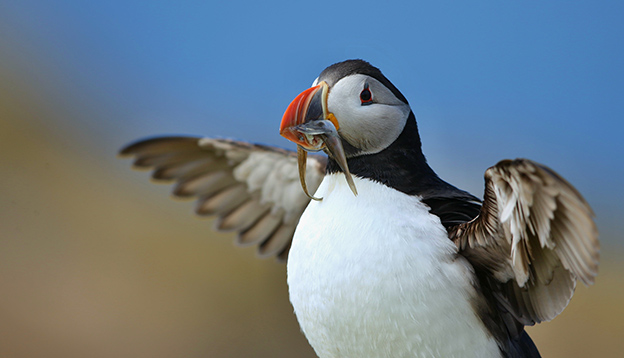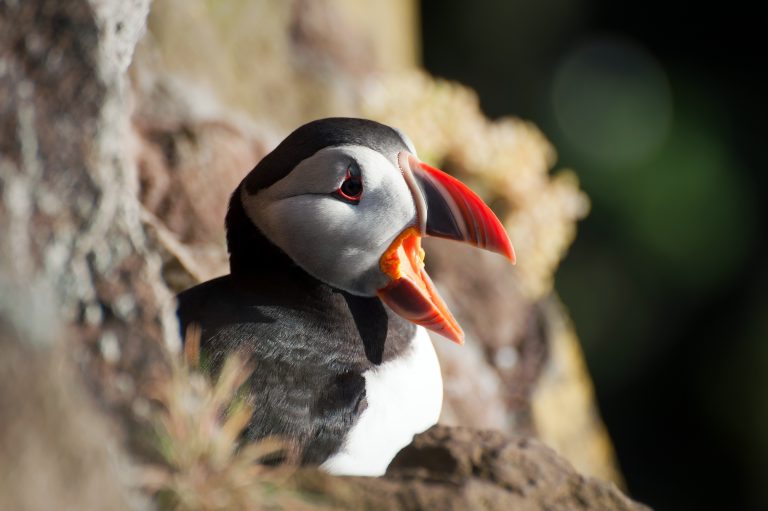Fun Facts About Puffins

Have you ever heard of puffins? These flamboyant little seabirds not only look absolutely adorable, but they are also full of surprising talents! The cuteness already starts with the name: Puffin derives from puff, meaning swollen because the pufflings (baby puffins) do appear rather stocky and round. To talk science, you can find three species within the genus Fratercula. These are namely the horned puffin, the tufted puffin, and finally the iconic Atlantic puffin. While the general Arctic region is home to these so-called ‘sea parrots’, more than half of the world’s puffin population is actually based in Iceland.
Read ahead for more interesting fun facts about one of our favorite Arctic birds!

Small bird, big mouth
Puffins are undoubtedly birds of many talents, but their distinctive bright orange beak might be their number one flex. To begin with, it can change its colour! Just before winter, puffins shed the outer layer of their beak every year, leaving it rather small and dull. Their bill only returns to its original orange colour right before spring, just in time to impress the ladies during mating season!
Want to know more? A puffin’s beak might not be the biggest one you have ever seen, but it fits an impressive number of fish in there! In fact, they can carry a whole stack of about twelve fish at the same time, thanks to their special tongues and upper palates. The puffin’s rough tongue pushes its catch onto a spiky patch at the top of its beak, where it stays put while the puffin continues diving to catch their favourite snack, sand eels. A puffin in Britain has been reported to have set the record for carrying the most fish with an incredible 62 fish in one go!
Sounds like we’ve got ourselves a coach for the next eating contest…
Half rabbit, half dog?
Puffins are highly extraordinary seabirds, and they like to do things differently than other winged species. A prime example? They don’t construct a typical bowl-shaped nest to breed their babies as most birds do. Instead, they copy rabbits and dig burrows about three feet into the ground with their beak and feet. Pretty dog-like, puffin parents shovel loose material out and then build a soft nest of grass and feathers for their baby in the back of the burrow.
Never running out of puff
Puffins roam the open Arctic Ocean for months at a time! In fact, these cute little seabirds only return to the shore once a year for breeding season. This is when they nest in the burrows they dig on predator-free islands and raise their pufflings.
But how do they even survive out there for that long? It’s all thanks to yet another clever natural adaption: Puffins have special glands behind their eyes that filter excess sea salt from their blood – that way, they are not reliant on freshwater sources and can therefore stay indefinitely at sea.
Love is in the air
Puffins form long-term bonds and are known to be monogamous. That means that pairs usually stay together for their entire lifetime, for better and for worse! However, they do migrate independently and spend the winter months apart from their significant others. Surprisingly, when coming back to the shore for breeding season, puffin pairs somehow manage to reunite at the same burrow to nest! Even more surprisingly – after all the thousands of miles that puffins fly to breed in their isolated areas, they only have one puffling per year.
Birds of many talents
Puffins are highly intelligent animals! Scientists have come to that conclusion as they have identified big-brain-behaviour in puffins which so far has only been discovered in primates and elephants. For instance, the Atlantic puffin has been observed using sticks and twigs as a tool to scratch themselves!
On top of that, puffins are pretty speedy fliers that can reach up to 55 mph – so don’t let their resemblance to flightless penguins confuse you. Puffins might look pretty clumsy when flying with their short wings and stout body. That is why they must put in some serious effort and flap their wings an impressive 400 times per minute to stay aloft.
They’re not only flying up in the air but even underwater! Well, kind of at least. While using their webbed feet to paddle forwards on the water’s surface, puffins flap their wings when diving underwater to move forward more quickly on their hunt for fish.
Questionable dinner menu
Back in the days, puffins used to be a popular dish in some Arctic areas when resources were scarce! Nowadays, they are protected and illegal to hunt in most countries except for Iceland and the Faroe Islands. Contrary to popular belief, most locals do not enjoy eating puffin that much. The meat is actually often described as too gamey for most people’s taste! It’s more of a culinary tradition and not made to be a tourist attraction due to the declining population numbers. So maybe just stick to the Skyr (dairy product) and plokkfiskur (fish soup) when visiting Iceland!
Vulnerable tweet-hearts
While the horned and tufted puffins are classified as ‘least concern’, the conservation status of the iconic Atlantic puffin was downgraded to ‘vulnerable’. In 2018, the European population has been estimated to be between 10-12m birds. However, numbers are declining rapidly! The most likely reasons for that development are an increase in predators on islands and our ever-present enemy number one called climate change.

In a nutshell, puffins might be small, but they are full of cool surprises and hidden talents!
They’re a real highlight on every trip to the Arctic. Explore their habitat yourself with a cruise to the Arctic region and join us on our vessel the Ocean Endeavour to discover the North Atlantic by boat!
Contact our team in case of any questions and we are more than happy to plan your trip of a lifetime.
Where Will You Go Next ?
- Popular Destinations
- Antarctica
- The Arctic
- South America
- Central America
- More to explore
- Amazon
- Antarctic Circle
- Antarctic Peninsula
- Argentina
- Bolivia
- Brazil
- Canadian Arctic
- Chile
- Colombia
- Costa Rica & Panama
- East Antarctica
- Ecuador
- Galapagos Islands
- Greenland
- Guatemala & Honduras
- Machu Picchu
- Mexico
- Patagonia
- Peru
- South Georgia and Falkland Islands
- Spitsbergen
- Sub Antarctic Islands

Talk to one of our experienced Destination Specialists to turn your Antarctic, Arctic and South American dream into a reality.
Contact us